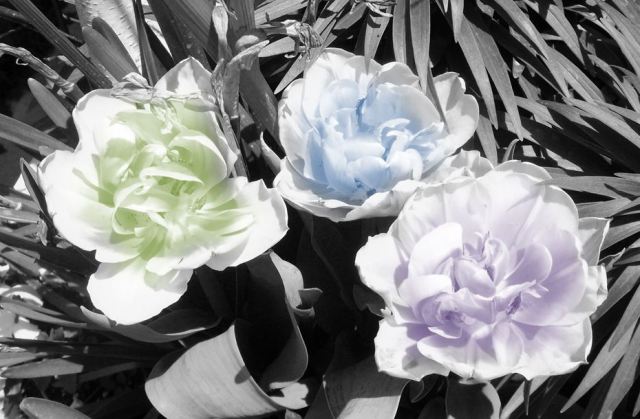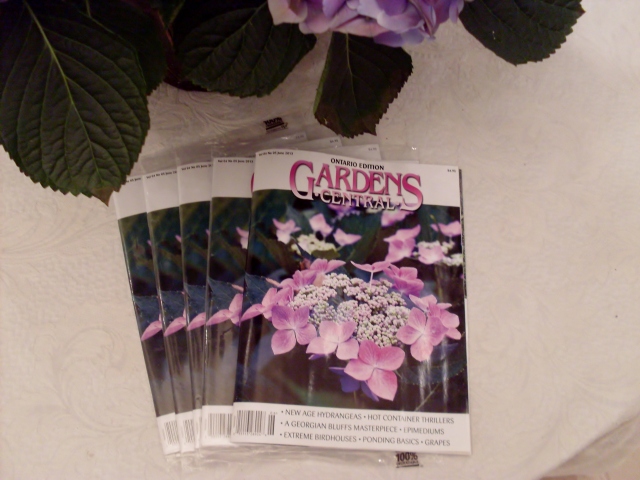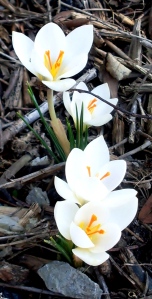
A small white crocus
Many gardeners are beginners. I see this from the number of gardening bloggers who say so, and from my experience living in and about a large city where people work constantly and are afraid to plunge into having much of a garden, because they don’t know how to put one together or how to look after a garden once they have it.
People constantly say that they don’t want to be tied to the maintenance of a garden–they work, they are away in the summer–and that is why they give up the joy of having their own personal piece of paradise.
One easy way to have a garden look after itself is to know what the conditions of the various areas of your property are and to plant only plants that love to be in those conditions. An experienced garden designer would never do otherwise!
Another is to choose mainly perennials: these plants grow back every year and do not need to be replanted annually.
Having said that, the following is my list of top plants for the beginning gardener. These are plants that are visually rewarding to grow, seldom if ever susceptible to pests or disease and thrive with little or no care.
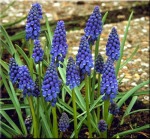 Grape Hyacinth Tiny but tough, this one will multiply very prolifically and can get carried away. However, it looks best in masses and is easy to pull out if necessary. Extras may be thrown into your spring planters as well.
Grape Hyacinth Tiny but tough, this one will multiply very prolifically and can get carried away. However, it looks best in masses and is easy to pull out if necessary. Extras may be thrown into your spring planters as well.

Carefree crocuses illuminate earliest spring
Crocus The easiest to care for of all the spring bulbs. While tulips and other beauties may weaken over time, crocuses will multiply (politely, though: not so as to become a nuisance). You can plant them in gardens or under your lawn for spring drifts of flowers before lawn mowing season begins.

Highly fragrant Lily of the Valley
Lily of the Valley The heavenly scent of this shade-loving classic will have you looking forward to their nodding, white bells every spring. They are charming and fragrant if cut for indoors, but keep children away from them, as they are toxic if ingested.

Lilac underplanted with various bleeding hearts
Photo from Fine Gardening Magazine
Lilac Plant lots of varieties for their beautiful and aromatic blossoms in May and June. Your children will forever associate their presence with the coming end of the school year. Once your plants are large enough you will look fondly forward to cutting them to bring their scent indoors each spring–and cutting flowers simply encourages more blooms next year! (However lilacs don’t generally require pruning to bloom.)
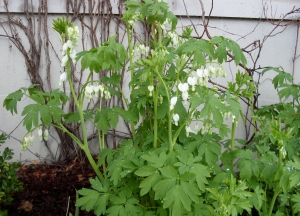
White bleeding heart, Dicentra Spectabilis “Alba” begins its reliable show in a shady spot
Bleeding Heart Lush and lilting by May or June, with a long period of bloom, these classic beauties look delicate but belie their carefree nature. You can clip them for arrangements alone or as a complement to dramatic flowers like peonies or lilacs. They are extremely winter-hardy, thrive in shady spots and their languid leaves provide contrast to other foliage after the main bloom period eventually ends. As long as they don’t completely dry out, the only care they will need is to have their dead stalks cut back for tidiness after they turn yellow in autumn. Bonus: they are also easy to divide once their root systems become large.
Peony If you don’t have these large-flowered stunners in your garden, you don’t know what you are missing. Cut them and bring them indoors for drama and scent. You will be in love for life. Deadhead them after blooming, but if you don’t, they don’t care! You will still get huge, fragrant blooms again next year. Various pinks, red or white, you will want to cut off their spent stalks in fall, just to tidy.

Huge, fragrant white peony
Peonies are incredibly long-lived and the number of old farmhouses in Ontario with hundred-year-old peony beds blossoming away are a testament to how easy these perennials are to maintain.
 Snow-in-Summer The reason I love this Ontario favourite is that its tiny, fuzzy silver-green leaves are a foil or complement to all the taller plants, and it fills in the edge of a garden beautifully. It will not seed all over your garden but creep vigorously in the area you plant it. Covered with a mass of brilliant, white, tiny flowers in June it s low-growing but still dramatic at a distance. Virtually no care is required, but you may have to pull it out around the edges if it creeps too far into other plants.
Snow-in-Summer The reason I love this Ontario favourite is that its tiny, fuzzy silver-green leaves are a foil or complement to all the taller plants, and it fills in the edge of a garden beautifully. It will not seed all over your garden but creep vigorously in the area you plant it. Covered with a mass of brilliant, white, tiny flowers in June it s low-growing but still dramatic at a distance. Virtually no care is required, but you may have to pull it out around the edges if it creeps too far into other plants.
Creeping Phlox Similar to Snow-in-Summer but with greener leaves , this is a ground-hugging mass of white, mauve or pink blossoms in late spring to early summer. It typically re-blooms without provocation with a less intense show of flowers later in the summer. Use them to edge a perennial border or mass various colours on a slope, always in a sunny area.
, this is a ground-hugging mass of white, mauve or pink blossoms in late spring to early summer. It typically re-blooms without provocation with a less intense show of flowers later in the summer. Use them to edge a perennial border or mass various colours on a slope, always in a sunny area.

Irises are hardy, stunning and easy to grow

These enormous blue irises tower about four feet tall but other varieties are as small as eight inches tall.
Iris Another “wow” flower in your garden. There are so very many colours, heights and varieties of iris that they cover a multitude of uses in the garden, and they are also beautful cut (if short-lived). They grow from a thick rhizome and multiply slowly. Divide them every few years for more, and to keep them healthy. Graceful Siberian Irises are a tough and resilient top choice.
Day Lilies These casual favourites look great in clumps beside hostas or other complementary plants, or in large, undulating drifts for great drama. There are many cultivars available now for bloom at almost any point in the summer, with plain or ruffly leaves and in many, many 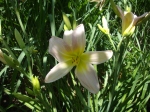

Day Lilies come in many colours and leaf shapes
colours, so try a few. You can mix them together for a longer show in one area, and their straplike, arching leaves look great beside many other plants even when they are out of bloom.

Pale day lilies bloom in gardens on either side of this pathway
Hosta cultivars Plant them in shade. Older varieties are typically most reliable but it is hard to go wrong, and the range of sizes (from plants you could lose your pets under like “Sum and Substance” or “Titanic”, to tiny, rounded or pointy-leaved varieties), colours and leaf patterns is truly staggering! Want more? Simply drive your shovel through the middle of your larger plants and re-plant new sections (subject to patents of new varieties). They look especially lovely under a row of hydrangeas!
Tip: plant hostas near grape hyacinths, tulips and other bulbs and their leaves will grow up and cover the leftover, dying debris when the bulbs finish blooming!

“Cool and Green and Shady”, large, arching Solomon’s Seal in bloom forms and backdrop to Hosta, “Big Mama” and Hosta Undulata “Variegata”
Solomon’s Seal This could be may all-time favourite plant, although saying that is a bit like choosing a favourite child. If you want your garden to look lush, as though you have the greenest thumb in town, then start with one or two of these. Each year, they double neatly in the number of stems, but never reach out of their spot to compete with neighbouring plants. I have grown them in sun or shade, and even under the evil, toxic black walnut tree next door. Arching like a fern, yet more lush and drought-resistant, they complement any other plant you want to put next to them.

Sedum, Autumn Joy blooms with grasses in this late summer garden. For more on this garden, click here.
Sedum “Autumn Joy” Regular readers will probably roll their eyes: I show you this plant in every season: cute, fleshy clumps of leaves in spring; fresh, green

Sedum “Autumn Joy” shows a hint of pink with butterfly bush and Pink Diamond Hydrangea in August
flower heads forming in summer and pink flower heads darkening to a burgundy-brown throughout late summer and fall, followed by their substantial, brown heads holding up pretty formations of snow throughout the winter! How could I not?
Need more? Pull off any leaf or piece of plant, put it in soil and water it! Full sun to light shade, this plant is a performer! Cut back in late winter or early spring to let new growth show.

Sedum “Autumn Joy”–very dark in October–cut for indoor use
So, those are the plants. Of course, start your garden with a good bed of quality topsoil for best results. You will need to weed but if you mulch bare soil you can minimize weeding.
Avoid fussing, staking, heavy fertilizing and losing blossoms next year if you neglect to deadhead this year: Start your garden with these plants and you will enjoy your success and your free time.
What are your favourite easy-care plants? If you have special favourites to recommend, please share below.
Click the follow button at top right to get gardening tips and inspiration in your inbox!




















